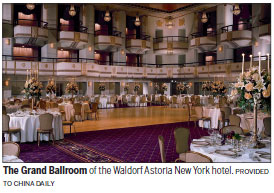

New York apparently wants to hold on to as many memories as possible of the cherished Waldorf Astoria hotel.
On Tuesday, the city's Landmarks Preservation Commission (LPC) voted unanimously to landmark several sections of the hotel's interior.
As for the exterior, that was designated a city landmark in 1993. The designations mean you can't mess with whatever's landmarked.
The vote will protect the building's most grand public spaces, including interconnected rooms and corridors on the ground, first, second and third floors.
The Waldorf has been in the news a lot lately, with many winsome testimonials to its grandeur and star status. The Park Avenue grandee closed on March 1 for what will be two to three years of renovations and an expected conversion mostly to luxury condos.
The Anbang Insurance Group of Beijing bought the Manhattan gem in October 2014 for $1.95 billion from Hilton Worldwide Holdings Inc, the US hotel giant. Hilton continued to manage the premises for Anbang, but it apparently will have fewer rooms to let when it reopens in 2019 or 2020.

"The Waldorf Astoria hotel has some of the most internationally renowned rooms in all of New York City," Landmarks Commission Chair Meenakshi Srinivasan said in a press release Tuesday. "Today's action not only protects the rich and beautifully detailed Art Deco features of the hotel's interior public spaces, it also preserves the unique experience of moving through the hotel's varied interiors, which countless New Yorkers and visitors have enjoyed for more than eight decades."
And that's OK with Anbang, which said in this statement on Tuesday:
"Anbang knows the Waldorf Astoria's history is a large part of what makes this hotel so unforgettable. That is why we fully supported the commission's recommendations for designation of the Waldorf Astoria's most important public spaces and applaud the commission on achieving landmark status for them. These designations are consistent with our vision and we look forward to presenting our plans for restoring these historic public and event spaces in the coming weeks."
Over the years, the Waldorf, which opened in September 1931, played host to such stars as Marilyn Monroe, Grace Kelly, Elizabeth Taylor and Frank Sinatra, and its Presidential Suite was where US presidents often spent the night in the city, at least until Anbang bought the place. But that's another story.
Landmarked spaces on the first floor include the Park Avenue lobby; an entry hall with 13 murals and a floor mosaic by the French artist Louis Rigal; and the wood-paneled main lobby with black marble pillars.
On the east end of the first floor, near Lexington Avenue, preserved are elevators with distinctive metal doors and double staircases with "frozen fountain" balustrades leading through the first, second and third floors.
On the third floor, designated spaces include the Silver Gallery, a long mirrored hallway with a black-and-white mosaic floor linking four ballrooms. The gallery has a coved ceiling with 12 murals by American artist Edward Emerson Simmons.
Then there's the Grand Ballroom, which has room 1,550 guests. The three-level space has projecting balconies and an elaborate ceiling relief. The room has hosted many dinners, banquets, galas and balls, including the annual Alfred E. Smith Dinner, attended by US presidential candidates.
In fact, it was just last October that the dinner was the setting for the lobbing of some caustic bon mots between then-presidential candidates Donald Trump and Hillary Clinton.
Also on the third floor is the Basildon Room, which has colorful wall and ceiling panels from an 18th century British mansion, as well as the Jade Room and Astor Gallery. They retain their original dimensions and share such features as gilded plaster reliefs, nickel-bronze metalwork, glazed doors, mirrored walls and wood paneling.
The LPC is the city agency responsible "for protecting and preserving New York City's architecturally, historically and culturally significant buildings and sites". It was created in 1965, two years too late to save the original Pennsylvania Station from being demolished.
Contact the writer at williamhennelly@chinadailyusa.com